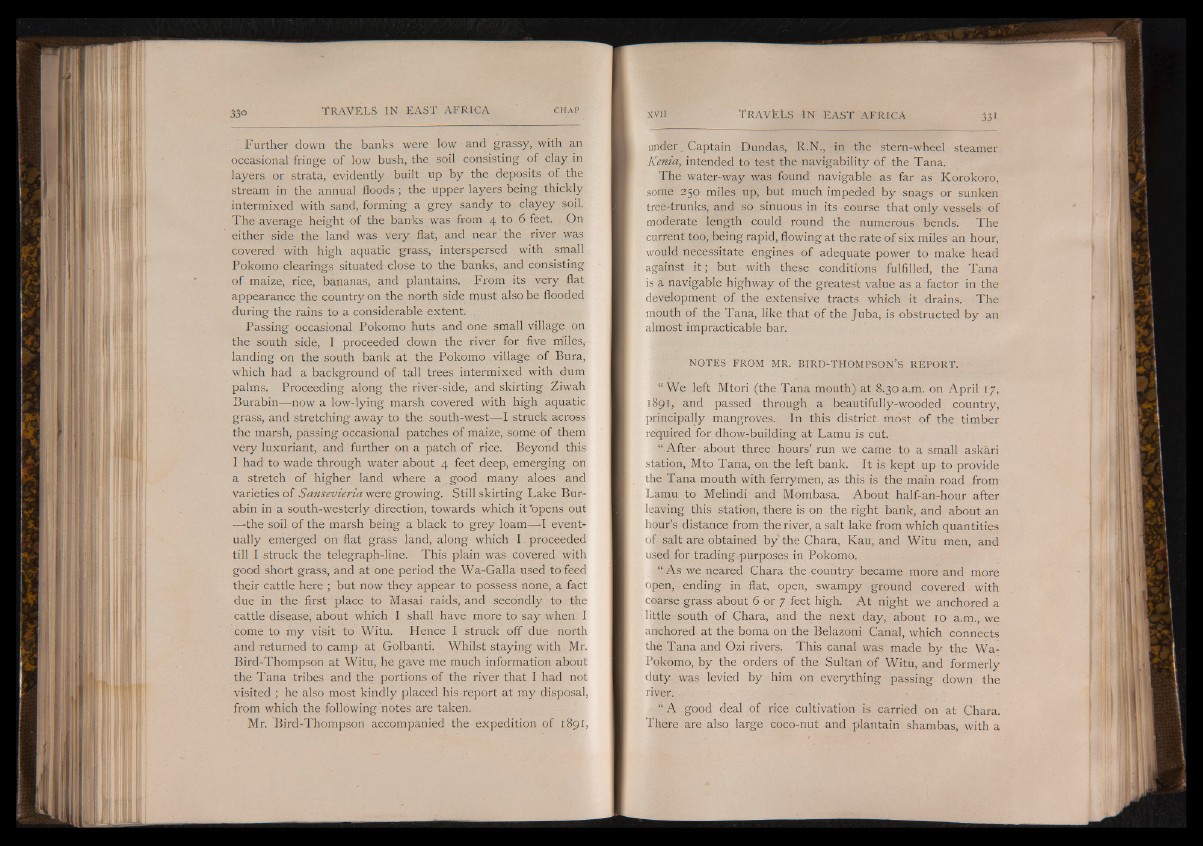
Further down the banks were low and grassy, with an
occasional fringe of low bush, the soil consisting of clay in
layers or strata, evidently built up by the deposits of the
stream in the annual floods; the upper layers being thickly
intermixed with sand, forming a grey sandy to clayey soil.
The average height of the banks was from 4 to 6 feet. On
either side the land was very flat, and near the river was
covered with high aquatic grass, interspersed with small
Pokomo clearings situated close to the banks, and consisting
of maize, rice, bananas, and plantains. From its very flat
appearance the country on the north side must also be flooded
during the rains to a considerable extent.
Passing occasional Pokomo huts and one small village on
the south side, I proceeded down the river for five miles,
landing on the south bank at the Pokomo village of Bura,
which had a background of tall trees intermixed with dum
palms. Proceeding along the river-side, and skirting Ziwah
Burabin—-now a low-lying marsh covered with high aquatic
grass, and stretching away to the south-west— I struck across
the marsh, passing occasional patches of maize, some of them
very luxuriant, and further on a patch of rice. Beyond this
I had to wade through water about 4 feet deep, emerging on
a stretch of higher land where a good many aloes and
varieties of Sansevieria were growing. Still skirting Lake Burabin
in a south-westerly direction, towards which it'opens out
-—the soil of the marsh being a black to grey loam— I eventually
emerged on flat grass land, along which I proceeded
till I struck the telegraph-line. This plain was covered with
good short grass, and at one period the Wa-Galla used to feed
their cattle here ; but now they appear to possess none, a fact
due in the first place to Masai raids, and secondly to the
cattle disease, about which I shall have more to say when I
come to my visit to Witu. Hence I struck off due north
and returned to camp at Golbanti. Whilst staying with Mr.
Bird-Thompson at Witu, he gave me much information about
the Tana tribes and the portions of the river that I had not
visited ; he also most kindly placed his report at my disposal,
from which the following notes are taken.
Mr. Bird-Thompson accompanied the expedition of 1891,
under. Captain Dundas, R.N., in the stern-wheel steamer
Kenia, intended to test the navigability of the Tana.
The water-way was found navigable as far as Korokoro,
some 250 miles up, but much impeded by snags or sunken
tree-trunks, and so sinuous in its course that only vessels of
moderate length could round the numerous bends. The
current too, being rapid, flowing at the rate of six miles an hour,
would necessitate engines of adequate power to make head
against it; but with these conditions fulfilled, the Tana
is a navigable highway of the greatest value as a factor in the
development of the extensive tracts which it drains. The
mouth of the Tana, like that of the Juba, is obstructed by an
almost impracticable bar.
NOTES FROM MR. BIRD-THOMPSON’S REPORT.
“ We left Mtori (the Tana mouth) at 8.30a.m. on April 17,
1891, and passed through a beautifully-wooded country,
principally mangroves. In this district most of the timber
required for dhow-building at Lamu is cut.
“ After about three hours’ run we came to a small askari
station, Mto Tana, on the left bank. It is kept up to provide
the Tana mouth with ferrymen, as this is the main road from
Lamu to Melindi and Mombasa. About half-an-hour after
leaving this station, there is on the right bank, and about an
hour’s distance from the river, a salt lake from which quantities
of salt are obtained by the Chara, Kau, and Witu men, and
used for trading .purposes in Pokomo.
“ As we neared Chara the country became more and more
open, ending in flat, open, swampy ground covered with
coarse grass about 6 or 7 feet high. A t night we anchored a
little south of Chara, and the next day, about 10 a.m., we
anchored at the boma on the Belazoni Canal, which connects
the Tana and Ozi rivers. This canal was made by the Wa-
Pokomo, by the orders of the Sultan of Witu, and formerly
duty was levied by him on everything passing down the
river.
“ A good deal of rice cultivation is carried on at Chara.
There are also large coco-nut and plantain shambas, with a